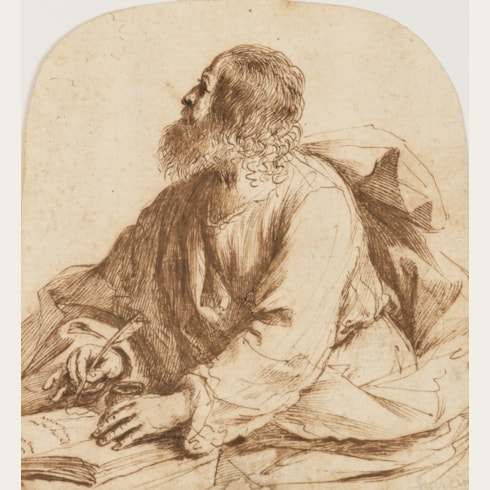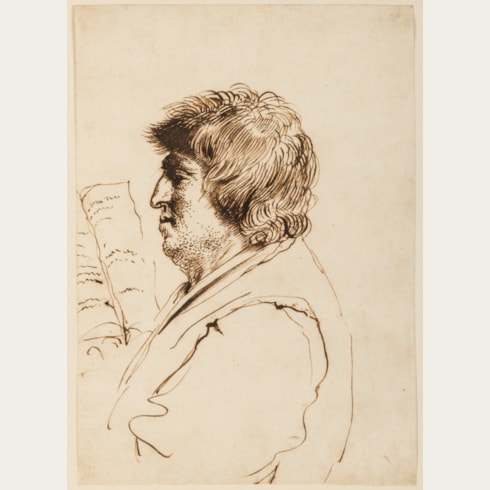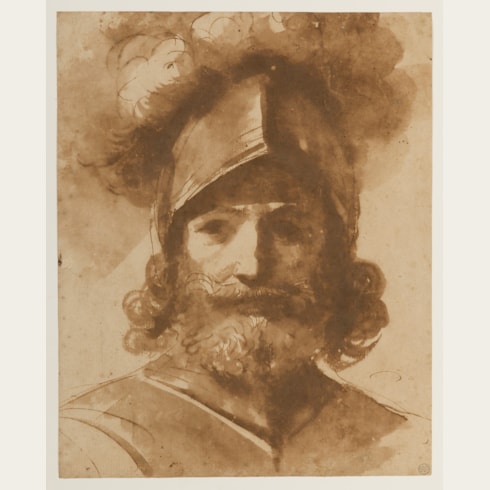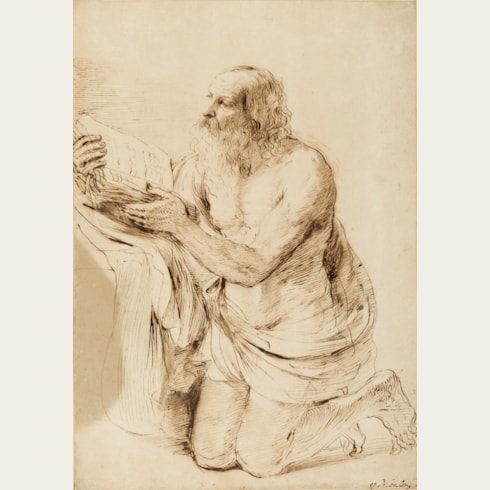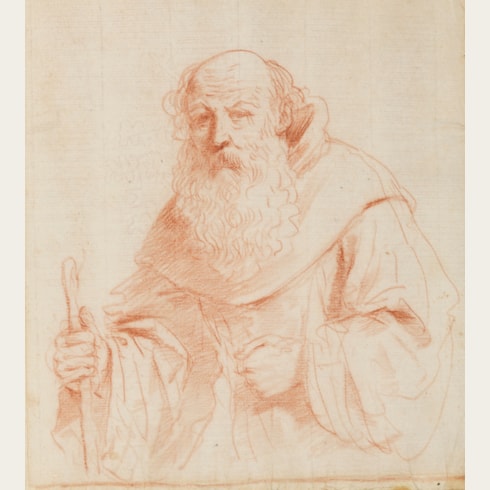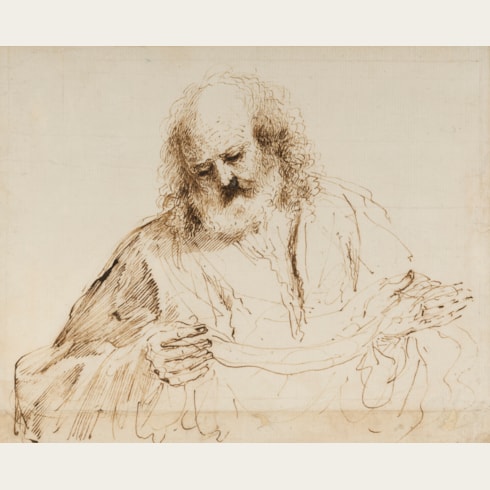Giovanni Francesco Barbieri GUERCINO
(Cento 1591 - Bologna 1666)
A Man Looking to His Left
Numbered (by Malaussena) 137 at the lower right.
200 x 192 mm. (7 7/8 x 7 1/2 in.)
The Guercino scholar Nicholas Turner has further written of such genre drawings that ‘they are characterized by a rapid touch, an economy of means, and a remarkable acuteness of observation, many of them clearly based on scenes taken directly from life. The foibles of the men, women, and children of all rank who were his unwitting subjects are captured with great immediacy, which has always given these drawings a special appeal. Although the nobles, gentlefolk, and clergy, largely from his native Cento, came under his powerful scrutiny, the most frequent subjects were the peasant folk, or contadini, for whom it seems the painter had a particular affection.’ Furthermore, as Julian Brooks has pointed out, ‘Given that Guercino travelled little and spent so much of his career in provincial Cento, it is no surprise that his caricatures and genre scenes reflect local life rather than political subjects. A gentle, sensitive humor and humanity characterize his work in this field and indeed pervade his entire graphic output.’
Among stylistically comparable drawings with the same predominant application of brush and wash, and with only a limited use of the pen, is a study of the head of a bearded man in a private collection, as well as a caricature of a man with bulging eyeballs, in the Royal Collection at Windsor Castle.
This drawing bears the collector’s mark of the 19th century French administrator and politician François Régis Alziary, Baron de Malaussena (1837-1905), who owned several drawings by Guercino. The present sheet later entered the collection of the French architect Paul Frantz Marcou (1860-1932), who served as inspecteur général des Monuments historiques et du service des objets mobiliers from 1893 onwards. He began collecting Old Master drawings from quite an early age, around 1880. His interesting and varied collection was made up mainly of 17th and 18th century Italian drawings, as well as sheets by Northern and French artists. On his death in 1932, Marcou’s collection was divided between his two daughters, Valentine (Mme. Jean Trouvelot) and Catherine, later Mme. Henry Dumas. The former presented her share of the Marcou collection, numbering just over two hundred drawings, to the Louvre in 1980. The second half of the Marcou collection, including the present sheet, was dispersed at auction in Paris in 2007 by the heirs of Catherine Marcou and Henry Dumas.
Giovanni Francesco Barbieri, known as Il Guercino (‘the squinter’) because he was cross-eyed, was by the second decade of the 17th century one of the leading painters in the province of Emilia. Born in Cento, a small town between Bologna and Ferrara, Guercino was largely self-taught, although his early work was strongly influenced by the paintings of Ludovico Carracci. In 1617 he was summoned to Bologna by Alessandro Ludovisi, the Cardinal Archbishop of Bologna, and there painted a number of important altarpieces, typified by the Saint William Receiving the Monastic Habit, painted in 1620 and now in the Pinacoteca Nazionale in Bologna. When Ludovisi was elected Pope Gregory XV in 1621, Guercino was summoned to Rome to work for the pontiff and his nephew, Cardinal Ludovico Ludovisi. It was in Rome that Guercino painted some of his most celebrated works, notably the ceiling fresco of Aurora in the Casino Ludovisi and the large altarpiece of The Burial and Reception into Heaven of Saint Petronilla for an altar in Saint Peter’s. The papacy of Gregory XV was short-lived, however, and on the death of the Pope in 1623 Guercino returned to his native Cento. He remained working in Cento for twenty years, though he continued to receive commissions from patrons throughout Italy and beyond, and turned down offers of employment at the royal courts in London and Paris. Following the death of Guido Reni in 1642, Guercino moved his studio to Bologna, where he received commissions for religious pictures of the sort that Reni had specialized in, and soon inherited his position as the leading painter in the city.
Guercino was among the most prolific draughtsmen of the 17th century in Italy, and his preferred medium was pen and brown ink, although he also worked in red chalk, black chalk, and charcoal. He appears to have assiduously kept his drawings throughout his long career, and to have only parted with a few of them. Indeed, more drawings by him survive today than by any other Italian artist of the period. On his death in 1666 all of the numerous surviving sheets in his studio passed to his nephews and heirs, the painters Benedetto and Cesare Gennari, known as the ‘Casa Gennari’.
The drawings of Guercino, which include figural and compositional studies, landscapes, caricatures and genre scenes, have always been coveted by later collectors and connoisseurs. Indeed, the 18th century amateur Pierre-Jean Mariette noted of the artist that ‘Ce peintre a outre cela une plume tout-à-faite séduisante’. The largest extant group of drawings by Guercino is today in the Royal Collection at Windsor Castle; these were acquired from the Gennari family by King George III’s librarian, Richard Dalton, between about 1758 and 1764.
Provenance
Possibly his sale (‘Collection de M. le baron de M.’), Paris, Hôtel Drouot, 18-20 April 1866, possibly part of lot 209 (as Guercino: ‘Bustes d’hommes. Deux dessins à la plume’, sold for 16 francs) or part of lot 208 (as Guercino: ‘Deux figures d’apôtres, jeune homme à mi-corps; homme versant à boire à deux guerriers. Quatre croquis à la plume.’, sold for 20 francs)
Paul Frantz Marcou, Paris (Lugt 1911b)
By descent to his daughter Catherine, Mme. Henry Dumas
Thence by descent until 2007
Marcou sale (‘Seconde partie de la collection Paul Frantz Marcou 1860-1932’), Paris, Hôtel Drouot, 23 May 2007, lot 26 (as Bolognese School, 17th Century)
Jean-Luc Baroni Ltd., London, in 2008
Private collection, London
Anonymous sale, New York, Christie’s, 24 January 2017, lot 37.
Exhibition






















